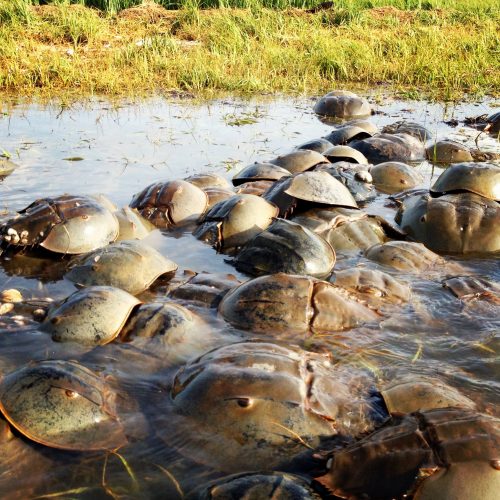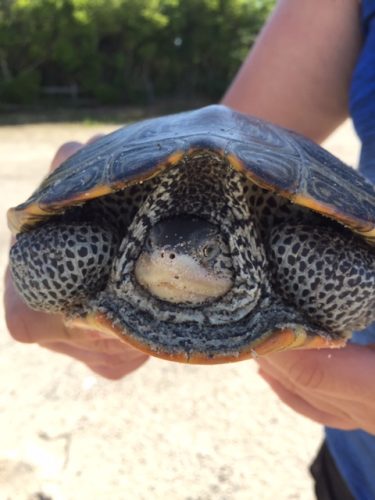According to Mitch, back in the 1980s when he first moved to the area, the Tuesday after Labor Day you could roll a bowling ball right down the middle of Rt. 1. While the nesting and migratory habits of homo sapiens have changed radically in recent years, for most species, life cycle changes are measured in decades, centuries, and eons. Which means that, even though nowadays weekend beach traffic is thick no matter the season, you still won’t see a Horseshoe crab in Little Assawoman Bay in January.
But where do our feathered, gilled, and web-footed friends go in the winter?

Bird-watchers and scientists have always known that Osprey, easily recognizable by their high-pitched call, daring plunges, and platform nests guarding over our bays, leave the Mid-Atlantic for southern climes around the same time kids return to school. But their final destination was a mystery. Now, thanks to tiny satellite transmitters fixed to the backs of these birds, scientists are gaining new insights into their impressive migratory journey.

In 2011, the Chesapeake Bay Foundation started an Osprey Tracking project. Although it ended in 2017, the journeys of three of their subject birds (Nick, Hackett, and Holly) are still available on-line to amaze you. All three took roughly the same route—south to Florida, a hop over to Cuba, then Haiti and the Dominican Republic, followed by a long crossing over the Caribbean Sea to South America coming ashore at the northern tip of Venezuela. At that point they split ways. Nick took a slight west turn and stuck close by—in Colombia. Hackett continued an easterly direction but didn’t leave Venezuela. And then there’s Holly. It looks like she wanted to experience Carnaval. She flew all the way to the eastern tip of Brazil—that’s over 5,000 miles! And we complain about driving down I-95 to Florida!
Male Osprey return to our area in March and begin tidying up the nest. The females come back about three weeks later (they went all the way to Carnaval after all!).

During May and June, Horseshoe Crabs are the reticent super-stars of our inland bays. They amaze us with their ancient spawning ritual, their sci-fi appearance and features, their significance to our eco-system and our medical system, and their longevity (as a species, they’ve remained basically unchanged for 450 million years!). But once summer has ended and the credits have rolled, they seek anonymity in deeper waters. Some studies show that they prefer waters less than 90 feet deep, but they’ve been found at depths greater than 600 feet. Some remain in the deeper waters of the bay, while many spend the winter on the continental shelf. Here they can quietly roam the sandy or muddy bottoms in search of food—decaying matter and immobile invertebrates—without being constantly recognized and having to sign autographs.

If you’re on the bay and you see a floating stick, and then it suddenly disappears, that stick was actually a Diamondback Terrapin. In salt marsh creeks, you’ll often spot them diving below the undercuts of the muddy banks. Terrapin are the only species of turtles in North America that spend their entire lives in brackish water. And they like to stay close to home, not wandering far from their birthplace for their entire lives. Which means that, even though we don’t see them this time of year, they are still there.

Turtles, since they are cold-blooded, take on the temperature of their surroundings. As their blood cools, their metabolic rate slows, meaning they need less food and oxygen to survive. In fact, in the winter, many turtles species can go 100 days without taking a breath of fresh air! They can get enough oxygen from the water by absorbing it through their skin.
For Terrapin, once the bay waters cool to sixty degrees, summer is over. They bury themselves in mud at the bottom of the bay, creeks, and ditches, hibernating until the changes in light and temperatures signal that spring has finally arrived.
Jenifer Adams-Mitchell
Owner, Coastal Kayak
Delaware Master Naturalist Program Participant
Research for this post:
https://www.cbf.org/about-the-bay/more-than-just-the-bay/chesapeake-wildlife/ospreys/osprey-tracking-map/
https://oceana.org/marine-life/cephalopods-crustaceans-other-shellfish/american-horseshoe-crab
https://www.horseshoecrab.org/nh/habitat.html
https://dickinsoncountyconservationboard.com/2019/11/18/painted-and-snapping-turtles-survive-winter-underwater/
https://www.pbs.org/newshour/science/the-secret-to-turtle-hibernation-butt-breathing
https://aqua.org/explore/animals/diamondback-terrapin
Diamonds in the Marsh by Barbara Brennessel
